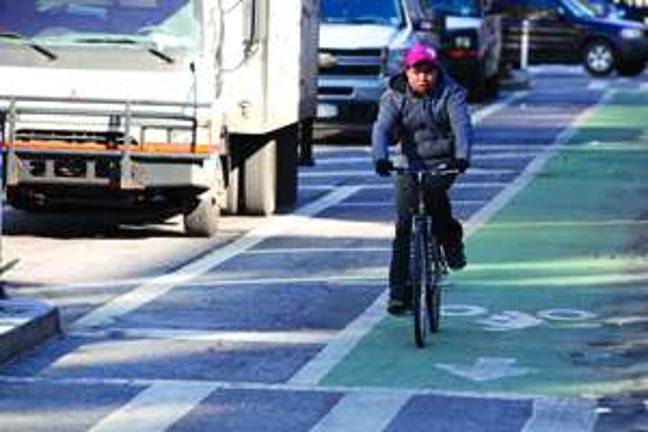CB7 Grills DOT on Columbus Avenue Bike Lane Extension

Manhattan Community Board 7's Transportation Committee held a public hearing last week on the proposed expansion of Columbus Avenue's bike lane. The city's Department of Transportation hopes to stretch the path from West 59th to 110th streets, more than doubling its current length from West 77th to 96th streets. Upper West Siders for and against the expansion packed into the meeting at Congregation Rodeph Sholom on West 83rd Street to voice their opinions, and left the committee undecided if it should endorse the proposal. The hearing opened with a presentation by the DOT that reviewed safety statistics of the current bike lane, which was installed in late 2010. According to the department, the one-mile stretch has seen a 48 percent increase in cyclists on the road since the path was created, with fewer cyclists riding illegally on sidewalks and a reduced rate of injuries. The number of crashes without injuries has actually risen, but the DOT attributed this increase to people getting used to the new setup as well as the greater number of cyclists. Josh Benson, the DOT's bicycle and pedestrian director, then introduced the expansion proposal, which aims to connect the Upper West Side to the bike lane that runs along Ninth Avenue. The majority of the extended lane would mimic the current path, with a green "protected" lane that is separated from car lanes by a painted section of road. This buffer zone, in some spots, is used for parking and pedestrian crossing islands. Between West 63rd and 66th Streets, in a complex set of intersections by Lincoln Center called "the Bowtie," the DOT would install shared bike lanes in which cars could drive, but not pass cyclists. Benson said that the lane extension would increase safety, reduce traffic congestion, make for greener streets and shorten pedestrian crossings. Many speakers from the public enthusiastically agreed. The majority of public attendees were in favor of the expansion, as demonstrated when Upper West Side Streets Renaissance Director Lisa Sladkus stepped up to the microphone for comments and asked supporters to raise their hands. "The status quo on our streets is unacceptable," Sladkus said. "We have the opportunity here to build something better, and the data from the first mile of this project tells us that we need to do it." Some supporters' endorsements were more tentative, however. Elizabeth Carpenter, a physician at New York University, spoke of getting sideswiped by a car in a shared lane. "It's just not enough without some sort of physical protection barrier from cars," she said, arguing against the safety of the proposed Bowtie path. Following comments, the Transportation Committee decided that they needed more time before voting to support or combat the proposal. The DOT already had said that it would not begin installing lane extensions until after winter, CB7 Chair Mark Diller pointed out, so no immediate resolution was necessary.